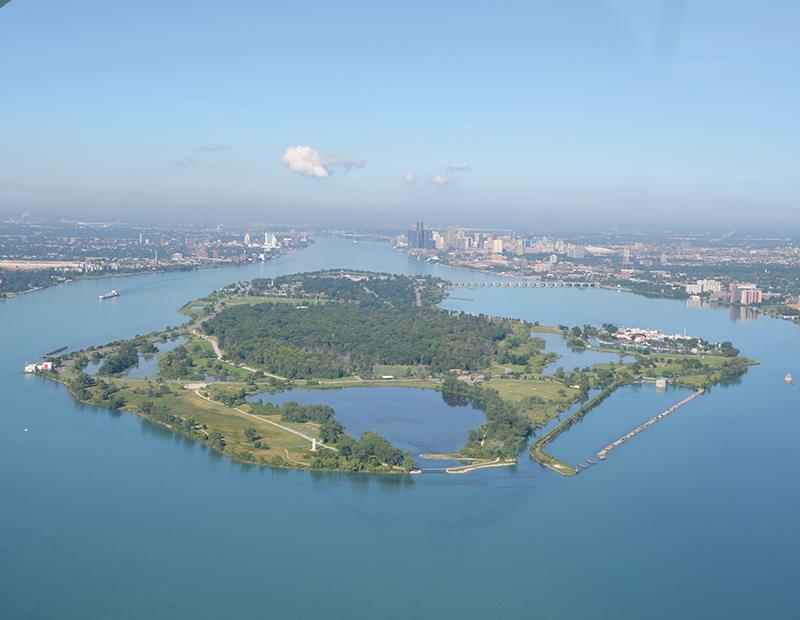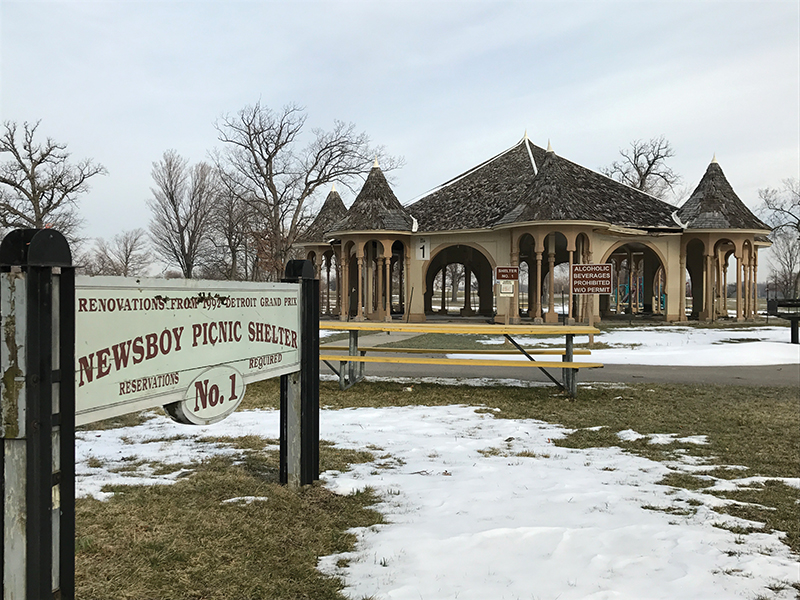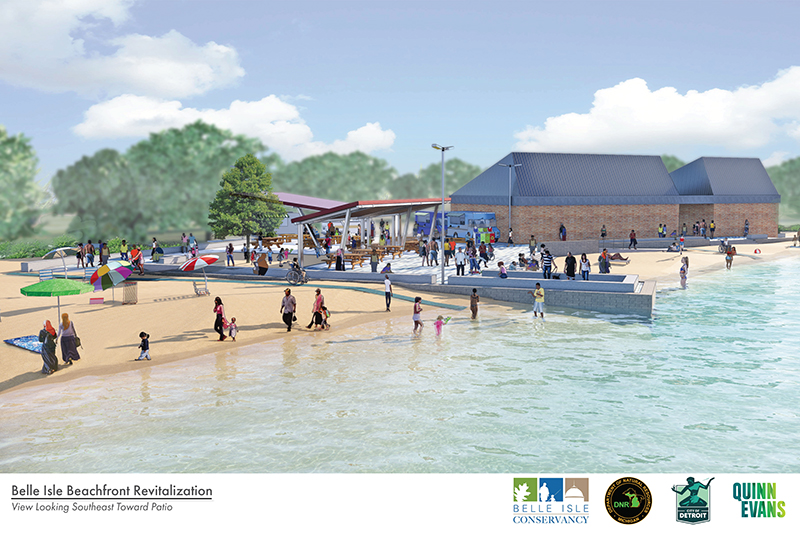
Just the name Belle Isle evokes warm, nostalgic feelings. Almost any resident of southeast Michigan, regardless of age, can recall pleasant memories of picnics and concerts, of casting a line from the fishing pier, or admiring the freighters plying the Detroit River.
A community fixture for well over a century, Belle Isle, at 982 acres, is larger than New York City’s Central Park. Its creation represented Detroit’s contribution to the City Beautiful movement of the late 19th and early 20th centuries, a design trend that featured elegant public buildings — often flanked by formal public spaces — and sought to replace urban congestion with a more aesthetically pleasing environment.
Belle Isle embraced this model and emerged as a treasure trove of architecture and design, featuring the work of landscape architect Frederick Law Olmsted, and of architects Albert Kahn, George Mason, and Cass Gilbert. Amenities such as the Anna Scripps Whitcomb Conservatory, the Belle Isle Aquarium, the Belle Isle Zoo, and a host of others made it one of the premier municipal parks in America.
Today, Belle Isle is emerging from a recent past marked by decay and neglect and has become a model of how public and private organizations can combine efforts and resources to meet a worthwhile challenge. The spirited commitment of several organizations working in tandem is ensuring that future generations will enjoy a thoroughly revived Belle Isle.
A Joint Effort
Although the island was long managed by the city, several booster organizations — the Friends of Belle Isle, the Friends of the Belle Isle Aquarium, the Belle Isle Botanical Society, and the Belle Isle Women’s Committee — formed beginning in 1972 to lend support. In 2011 all four combined to create the Belle Isle Conservancy, or BIC, to reduce redundancy and better coordinate their efforts. Michele Hodges, the current president, became the group’s first full-time employee two years later.

But as the city’s bankruptcy loomed, the island’s fate became a political football. In 2014, Detroit’s emergency managers — over the City Council’s objections — struck a 30-year lease with the state Department of Natural Resources, making Belle Isle Michigan’s 102nd state park. As part of the Michigan park system, Belle Isle can benefit from the greater resources the state can bring to the table. Today the DNR, partnering with the BIC and a dedicated group of other booster organizations, is ushering in a new era of renewal and rejuvenation by systematically tackling decades of neglect.
“We just hit the five-year point of the DNR’s lease, and so far, the state has invested $70 million in needed improvements and repairs,” Hodges says. “But this represents just the tip of the iceberg.” Most of that money, she says, went to urgent infrastructure needs, such as upgrading utilities and winterizing restrooms.
Amanda Treadwell, urban area field planner for the DNR, says these initial efforts were aimed at making the island clean and safe before more extensive renovations can be undertaken. Another of these critical, if unglamorous, short-term tasks will be to repair roofs on historic buildings to hold them over until they can be fully restored.
Those buildings include the White House, built by Alexander Macomb Campau in 1874 as his family’s summer home. It was later used for the park’s administrative offices. Another, the Belle Isle Police Station, was built in 1893. Designed by George Mason (who also designed Detroit’s majestic Masonic Temple), it drew inspiration from Norman-style farmhouses, incorporating a fieldstone exterior with red shingle roof — features rarely used in Michigan. The 1898 Belle Isle Horse Stables, also in need of shoring up, were used to board the horses of city workers before the automotive era, and subsequently housed police horses.
Long List of Needs at Belle Isle
Belle Isle is essentially three parks in one — the formal portion on the western tip, which sees the most visitors; the athletic complex on the southern edge; and the forested areas occupying the western half. Each section has its unique role and specific needs, making the restoration task complex.

A lot of criteria must be weighed to determine which projects deserve the highest priority, Hodges says, including the number of visitors served, the existing condition of each building or site, a site’s historic significance, and the cost of renovating or restoring it. Other considerations include any restrictions benefactors have placed on the use of donated funds, and the challenge of making attractions conform with the Americans With Disabilities Act.
“Unfortunately, it’s like drinking from a fire hose,” Hodges says when contemplating the vast array of projects in waiting.
The DNR recently commissioned a master plan that, when completed, will help it formulate a comprehensive renovation strategy. For now, a less extensive but still voluminous (198 pages) 2018 management plan is guiding DNR’s efforts.
That plan cites the James Scott Fountain as a top priority. Situated near Sunset Point at the western tip of the island, the white marble fountain with its 125-foot spray was designed by architect Cass Gilbert and sculptor Herbert Adams. It presents such a captivating scene that it was used as a backdrop for the 1973 movie Scarecrow.
“Several hundred thousand dollars have been spent to make it operational and ADA [compliant],” Hodges says. “But a full restoration could run more than $10 million. We’re forced into a ‘duct tape’ situation”
Funding for work on the fountain was generated by the annual Grand Prix race. Held each May, the event remains a point of controversy. While the money raised is certainly needed, critics contend that the noise and disruption produced by the race are at odds with the identity of a public park, part of which is devoted to nature.
Other top restoration priorities include work on the conservatory and aquarium, the beachfront, and the Newsboy Shelter, which is listed in the National Register of Historic Places.
The shelter, built in 1891, is situated at Picnic Way and Central Avenue, adjacent to the James Scott Fountain. Its turrets and columns evoke nostalgia for picnics and barbecues at the turn of the last century. Officially known as Shelter Number One, it takes its popular name from the nearby memorial to James Brady, founder of the Old Newsboys Goodfellows of Detroit Fund.
Building a ‘People Magnet’
To augment efforts by the DNR and BIC, other outside groups are bringing their energy, expertise, and fund-raising prowess to Belle Isle as well.

One of them is the Music on Belle Isle Group, or MOBIG, an alliance of local concert bands. The organization formed three years ago and has a two-pronged mission, its president, Craig Strain, says: The first is to bring live band music back to the island; the other (of equal importance) is to restore or replace the Remick Band Shell.
The band shell was built in 1950 and is named after Jerome Remick, who owned a Detroit music publishing business in the early 20th century. Around 1980 the Detroit Concert Band, which regularly performed at the facility, relocated to the Michigan State Fairgrounds. The abandoned facility sustained water damage and was rendered unusable. MOBIG recently met its goal of raising enough money for a professional architectural evaluation of the structure to determine whether restoration is feasible.
Near the band shell is the site for Oudolf Garden Detroit, a project designed by noted Dutch garden designer Piet Oudolf, whose other projects include the High Line in New York City and the Lurie Garden in Chicago. When completed by this summer, the garden will surround the existing Nancy Brown Peace Carillon and will feature plantings characteristic of the New Perennial movement, which emphasizes above all plants’ adaptability to different seasons and, secondarily, their color and shape. Although situated in a formal setting, the garden will take on a more natural appearance, featuring tall specimens of more than 100 native and non-native species of muted colors planted in liner garden beds some 100 feet long.
The project will incorporate the legendary Canadian Peace Monument. Dedicated in 1941 and designed as a bench, the light gray granite memorial celebrates over a century of peace between the U.S. and Canada. The structure is slated to be dismantled, cleaned of graffiti, and reinstalled at a higher point to protect it from sinking.
“Wherever Piet’s gardens are, people come — and in huge numbers,” says OGD spokeswoman Maura Campbell. She expects the project to be a “people magnet.”
The hope is that the attention the garden generates will motivate more people to commit to Belle Isle’s overall renewal by becoming involved in any of the numerous restoration efforts.
“The need on the island is so great that the conservancy is only [able] to reach our goals with the support of like-minded partners who share in the belief that Belle Isle is a treasured facet of Detroit’s culture,” Hodges says. “This is no easy task, as it requires tenacity, and grit, but isn’t that the very essence of what it means to be a Detroiter?”
Plus: The Island Ecosystem is Also in Need of Renovations

An often overlooked but important area of concern on Belle Isle is the health of its ecosystem.
Decades of ill-conceived ideas, including using landfill to block the flow of the island’s canals into the Detroit River, resulted in water stagnation and damage to fish and wildlife habitats.
In 2017 the Friends of the Detroit River secured funding through the National Oceanic and Atmospheric Administration to connect Blue Heron Lagoon to Lake Okonoka, which in turn will be opened to the river. A culvert and a new roadway bridge are included in the project, which is nearing completion.
Bob Burns, riverkeeper for the FDR, says the project will improve recreational opportunities, including fishing, on the island.
“Opening the island’s waterways to the river,” he says, “will allow walleye and salmon to spawn in the shallower waters, while species such as bass and bluegill will be able to transit through the island’s lakes and canals.”
|
|
|











